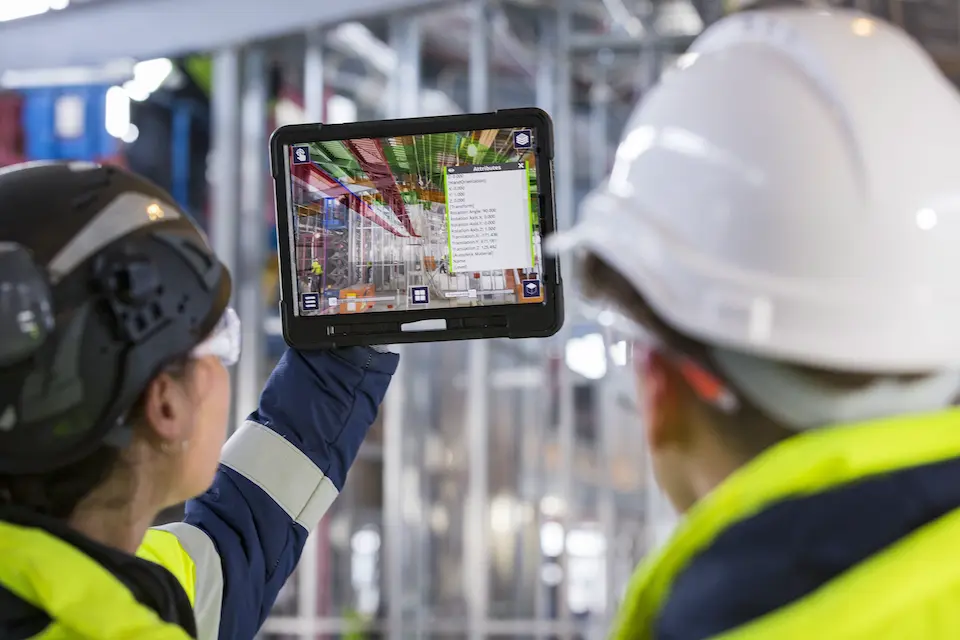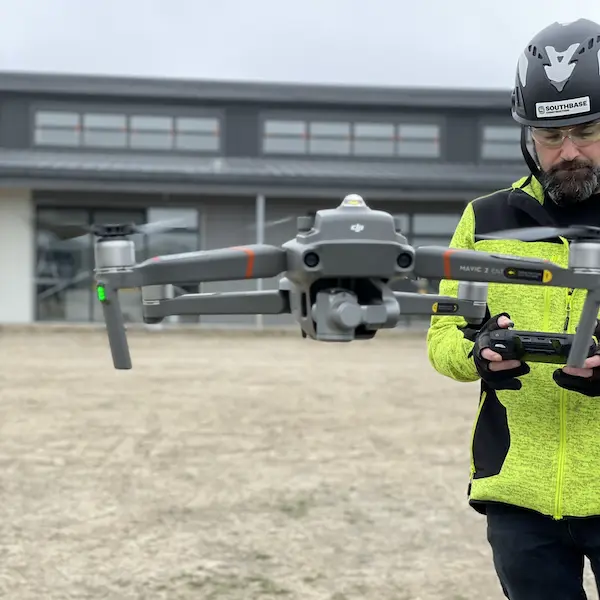
Dropbox, drones, and AR: How Southbase Construction saves time and money
Published on June 28, 2023
While many industry peers stick to traditional tools, these Kiwis are leaning into leading-edge technology to find efficiencies.
Lem Prestage has been an early adopter for as long as he can remember. Even when he was at college working towards a degree in education, he couldn’t get his mind off technology.
“In one of my first jobs, I worked for a college to teach the elder generation how to use computers,” he recalls. That experience sparked the idea of combining his teaching skills with his unshakeable curiosity about technology. He realized what he really wanted to do was show people how to use technology to simplify their lives.
That unique combination of skills helped him land his role as the National IT Manager at Southbase Construction, based in Christchurch, New Zealand. There, the leadership team relies on Prestage to translate emerging capabilities into company benefits. “They want to know: What are we going to get out of it? How's it going to improve things?”
So when Southbase experiments with drones at building sites or makes plans to use machine learning to analyze patterns and find efficiencies, Prestage is the person who interprets the data and explains how new tools will save time and money.

“We want to stay ahead of the game, but we need to make sure we have the technology available to keep up with growth.”—Lem Prestage, IT Manager
Over the past decade, Southbase has become renowned for delivering large-scale projects faster and more efficiently than the competition. On projects such as the Massey University Innovation Complex, the company had remarkable success combining building models with drone footage to create 3D views of works in progress.
Prestage and his team rely on technology for remote collaboration as well. With 85% of their workforce distributed across the country, they count on tools such as Dropbox to keep everyone on the same page even when many are out of the office, working at construction sites.
We spoke with Prestage to find out how the Southbase team has embraced an early adopter ethos to streamline their processes, reduce costs, and save time.
From an IT perspective, what are the biggest obstacles you face on a daily basis?
The biggest issue is ensuring that the technology we use is up to date and relevant. At the moment, we're upgrading all our laptops because of the amount of modeling we use across pretty much all our projects. We found that the laptops we're using are struggling with rendering those 3D models. So we're upgrading 160 laptops across the country in seven different regions with a team of five. It’s quite a challenge.
Then we go to those regions and [ask] “What are the road blocks in the technology you're using?” We found both the laptops and iPads we use need to be upgraded to fit the purpose. We want to stay ahead of the game, but we need to make sure we have the technology available to keep up with growth.
How has the company’s use of technology evolved in recent years?
When I started [at Southbase], everybody was VPN-ing in, then jumping onto a remote desktop and doing everything there. We had to roll out more and more services as we got more and more people on. And I'm like, this is just crazy. So that's where Dropbox came in. Even though we use other collaboration platforms, Dropbox gave the better offering for what we needed: Proper version control, distributed backups, and the security that goes above on that, having it locked down to our domain.
When we shut down [during the pandemic], everybody was working from home. It wasn't an issue with us. We are 100% laptops. 100% mobile. It was seamless. I've known of companies that were like, “Oh no—we've got 48 hours to start working from home!” We just carried on. And Dropbox was a massive help in that, because everybody had access to all their files instantly. The pandemic's been a good proof that what I was trying to achieve was the right way to go. If 180 people had been trying to VPN in to grab these files, it would have been a nightmare. Dropbox has been a really good partner to help us move forward in collaboration. It’s definitely helped.

“We just carried on. And Dropbox was a massive help in that, because everybody had access to all their files instantly.”
Could you give an example of how you’re using emerging technology on recent projects?
We’re in a coalition to build the new sports stadium module in Christchurch, which is very exciting. We've been involved in a lot of the keystone projects around the rebuild of Christchurch after the earthquakes. This one is kind of the icing on the cake. We're using a lot of technology on that—building information modeling (BIM) and overlaying our drone footage.
BIM provides 4D-model sizes. Visual 3D, but the fourth dimension is time. That's why we have to have laptops with graphics cards now. Traditional laptops can’t cope with that 3D rendering of a BIM model. For a smaller building, that's not too bad. But for the complexities of a stadium, we can use building information modeling on top of the drone footage so you can see a 3D model.
Having that, we can use augmented reality to put that on top of what we've built and say, “We’re ahead of time here, behind time here.” We can check that things are exactly in the right place, because accuracy is down to about three millimeters. That’s where our AR and VR usage is coming into effect. Using drone technology combined with the [BIM] models, we’ll be able to hold up the model on the iPad, have a look at where the door is, and say that is in the right place or not in the right place. It’s pretty awesome.
Is Southbase the first construction company in New Zealand to use drones that way?
Our drone partners said we seem to be using it the most. We've adopted that quite quickly and in a variety of use cases. A lot of people use drones for marketing purposes—and we do that as well. But we're using it in a practical sense for reality capture. We can actually use that over time. If we need to go back after we've put on the outside of the building to find out exactly what's underneath, we can actually scroll back in time, move the whole build process backwards and go, “Yeah, that's what under under this facade. We need to make a change here or there.”
How might machine learning and AI tools enhance the way you work?
A lot of it we could use to analyze lessons learned as projects are progressing and refine where savings can be made. Especially for our school projects. We build a lot of schools. A lot of them are based off the same models, and each time we get those learnings. But we could use machine learning and AI to analyze the differences and predict the workflow on a project moving forward.
All this data—a lot of in Dropbox—is sitting there waiting to be used. That's going to help us predict how many people we’re going to have on sites, and therefore the cost of the project to any one time. If it's a multi-year project, we’ll actually be able to analyze that cost savings from one school to another.
“We started rolling out Dropbox Sign about three years ago. We've reduced our print by about 30%, which is great for both cost savings and environmental factors.”
Then we can start using those learnings because it’s almost a carbon copy. We can go, “On this build, this is how many people we had on this site. Let’s predict what we’ll need on this one. Do there need to be apprentices?” That's something we’re starting to work on now—the modeling of what type of people we need, how many people, and the costs as we’re going through.
Which tasks do you hope AI and machine learning will be able to take off your plate?
For machine learning, it would be automating all our reporting so we can get the AI to actually mine all that data—which is definitely definitely doable now, but there's a lot of setting up. But if we can actually get ML to spin out [learnings from common patterns] when you go from one project to another—that will be really handy. Our leadership team can then go “This project just started—what learnings can we see already?” They'll be able to see that instantly.
Could you give an example of a tool you adopted that’s had significant impact on the business?
We started rolling out Dropbox Sign about three years ago, We’ve now got the whole leadership team using it on a daily basis. Our team is using it increasingly to sign off on internal and external contracts. Seeing that scale is going to help us on a collaboration front and on our Environmental Social Governance front as well. ESG is a major factor in our projects now, sometimes up to about 20% of some tenders have a sustainability goal attached.
Using Dropbox Sign means that people aren't printing things out, signing them, scanning them back in, having someone else print them. We've reduced our print by about 30% over the last three years, which is great for both cost savings and environmental factors. We're saving the planet one contract at a time, you know?



